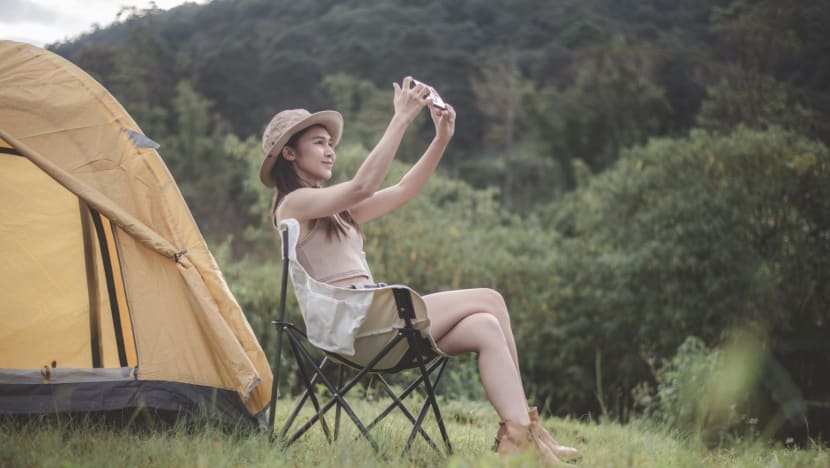Commentary: Posting on social media is one of the most expensive habits of our generation
We all know that social media is not really free. But your Instagram grid, TikTok reels and the experiences you fill them with may cost more than you think, says Annie Tan.


This audio is generated by an AI tool.
SINGAPORE: One could say our mobile phones are the closest relationship we have today - they join us on every social engagement and date. We may not know where our partner is before we go to bed, but we always know where our mobile phone is.
One big reason for this is social media. It is our culture of constantly sharing the most noteworthy parts of our lives with “followers” throughout the day - our coolest activities, latest shopping haul, the Dalgona we had at that cool cafe. We turn every weekend, every holiday, every significant and insignificant life experience into “content”.
For this reason, our mobile phones are also probably one of the most expensive relationships we have. As they say, the “camera eats first” and it does not like to eat cheap.
Several decades ago, Starbucks transformed cafe culture by marketing itself as a place for connection outside of work and home. Today, social media is fuelling the next cafe evolution via a different type of connection - social media shares and a check-in culture.
We have all seen the new breed of “Instagrammable cafes”. But “Instagrammable” as an adjective is not just driving consumer spending in dining, but also in travel, luxury and leisure. These days, it feels like every other hotel has an infinity pool, and every millennial, Gen Z-er and beyond has posted an infinity pool photo on social media.
Well, two and a half years ago, I broke up with Instagram. It was not a conscious decision. I simply stopped posting because I was just going through a stressful life transition.
Looking back, I have saved so much money and mind space.
ARE WE PAYING FOR LIKES?
Almost three decades ago, in 1997, the concept of personal branding was seeded in an essay by management expert Tom Peters. It is this idea that individuals need to shape their own reputations and careers by cultivating a personal brand.
Since then, this idea has practically exploded with the rise of social media.
Today, we are shaping our public persona every single day - what drinks we like, what clothes we wear, what lifestyle we have and can afford, what we think, what coolest dance moves we have mastered. We take great efforts to share this with the world.
Ninety-two million selfies are taken every day globally, according to one study. Made popular by social media, a selfie is not just a self-taken picture. It is strategically framed, edited and curated to tell our narrative.
A viral TikTok video even suggests that different generations style their selfies differently, with Gen-Zer projecting lowkey cool, millennials posing with lifestyle “props”, Gen-Xer checking in at different hot spots, and Boomers still figuring out the whole concept of selfies.
And it is not just selfies. When you think of it, aren’t flatlays - another social media trope - essentially just laying out all our goods for an airbrushed and envy-inducing effect?
There are also back views shots, pensive shots and other highly staged photos that have notoriously caused obstruction in many tourist spots. People are willing to pay a pretty penny for those. That swing over rice paddies in Bali - I have seen a package for it costing S$40 (US$30), with an extra S$20 charge for dress rental.
When it comes down to it, we do most of this for bragging rights, which of course, social media enables and amplifies. Indeed, there was a time when if you travelled to an exotic destination, splashed out on omakase or stayed in an expensive hotel, it would be culturally inappropriate to milk your splurges for praise and social credits, especially among distant friends and acquaintances.
Whether consciously or unconsciously, this social affirmation - in the form of likes, hearts, comments and shares - can be so addictive that it fuels spending and shopping that might otherwise not happen. And of course, retailers, hoteliers and restaurateurs know this.
EDITED FEED, EDITED LIFE
One reason we are so drawn to social media is because it is simply human to want to share our lives, experiences, opinions and wins. As social creatures, communication, connection and community are essential for survival.
It makes sense on many levels. Sharing experiences on social media can create a new commonality between old friends, or even strangers, or be a catalyst for conversation.
Even a humble cafe selfie can serve a purpose. In a world spinning at breakneck pace, it says to people you have otherwise lost touch with: “Remember me? I’m still alive. Come say ‘Hi’?”
The thing is, when presenting ourselves, the vast majority of us want to be seen as cool, relevant, doing well, living the life, having good experiences, having good taste. And sometimes, we over-edit our lives to create an altered reality, shaped by trends.
I have known people who blow disproportionate amounts of their salary on Instagrammable experiences, avocado toast and fancy coffee. Admit it or not, most of us feel some pressure to try to keep up, and that can also be very bad for our bank account.
In some cases, in bid to edit our feed, we also edit our lives. My helper recently told me about a friend who returned home a few months into her employment contract because her husband had cheated on her. I can imagine it must have been an incredibly difficult period for her. But no one would know this, because upon returning, one of the first things she did was pay for a pedicure, mainly for reels.
DISCONNECTING TO RECONNECT
However, perhaps if we look at it from another perspective, one reason we share so much on social media is that it gives us the illusion that we are not alone, we are heard.
Even at 2am when everyone we know is asleep, there is always somebody there, lurking on social media. This is why some of us unconsciously spend so much to produce content that people will respond to, to fill some void.
The irony is that while social media enables users to constantly connect with everyone, it also makes us disconnect from the people who are actually beside us.
In fact, the rationale behind the “photos, or it didn’t happen” mindset is the idea that it is not enough to share any experience with the people who are actually present. We need to share it with a wider audience for it to be meaningful.
At this point, I should probably clarify that I am not advocating that people should go off social media. It has become such an integral part of our lives that that would be a ridiculous ask.
But as with most co-dependent relationships, some boundaries when it comes to social media might give us some perspective.
In my case, my unplanned and unintended social media detox has been positive.
I still live like life is short. I do not feel less connected or fulfilled. But I no longer think of food, travel or life as a great photo op.
I still take photos, but my camera feed no longer has pictures of sundowners, sushi or stunning cafes. Because let’s face it, I doubt these will be photos I want to look back on when I am 70.
While I can’t say for certain that I will never be swept up in the social media wave again, so far, this detox has surprisingly done so much for my self-perspective and bank account.
Annie Tan is a freelance writer based in Singapore.




















